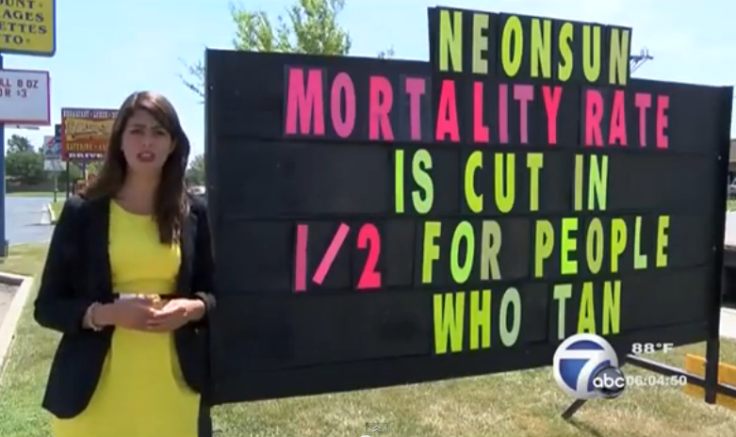Texas Tanning Salon Claims Tanning Beds Prevent Skin Cancer: 3 Sunbathing Myths Debunked By Science

The desire for glowing, radiant, and sun-kissed skin leads beachgoers to make nearly 100 million trips to the beach, and 30 million people to tan indoors in the U.S. every year. While society has perpetuated the idea a tan gives people a “healthy glow,” in reality tanning is the skin trying to protect itself from sun damage. Premature aging, eye damage, and skin cancer are not only risk factors associated with sunbathing, but also indoor tanning. However, Blake Goldston, business owner of tanning salon Neon Sun in Texas claims tanning beds and sun lamps can help with skin cancer prevention, and other diseases, manipulating claims from the Centers for Disease Control and Prevention (CDC).
There is no research that exists that shows a causal relationship between indoor tanning and increased incidents of skin cancer and melanoma,” Goldston told KVII-TV, an ABC affiliate station in Amarillo. Goldston claims several reports from the CDC back his claim showing there is no direct correlation between tanning beds and skin cancer. The tanning salon owner also remarks current studies don’t actually show enough evidence, and the number of skin cancer cases are actually decreasing.
“It’s interesting that in the U.S., the incidence of melanoma has been on the decline and I quote from the American Cancer Society is significantly less than two-tenths of one percent, and to the people who tan indoor is exactly the same. There's just no evidence showing anything different," Goldston said.
On the opposite side of the spectrum, U.S. Surgeon General Boris D. Lushniak, has for the first time shed some light primarily on skin cancer in his report, urging ordinary Americans to take long-recommended preventive steps such as wearing sunscreen and seeking shade when outdoors. Lushniak’s “Call to Action to Prevent Skin Cancer,” presents the following five strategic goals to support skin cancer prevention in the U.S.: increase opportunities for sun protection in outdoor settings; provide individuals with the information they need to make informed, healthy choices about ultraviolet (UV) radiation exposure; promote policies that advance the national goal of preventing skin cancer; reduce harms from indoor tanning; and strengthen research, surveillance, monitoring, and evaluation related to skin cancer prevention.
The surgeon general’s warning comes after a spike in the cases of deadly melanoma. The report cites a 200 percent jump in deadly melanoma cases since 1973, emphasizing a continuously growing generation of tanners. This sun worshiping has led to $8 billion spent to treat all forms of skin cancer each year. "We need more states and institutions on board with these policies that discourage or restrict indoor tanning by our youth," Lushniak said. "Tanned skin is damaged skin."
Despite the concrete evidence, and warnings from the surgeon general, Goldston and other tanning salon owners like Lisa Ferguson, who owns Baja Tan in Ohio, don’t agree with the recommendations and believes her salon is a “safe environment” for kids to tan. “If kids tan outside it’s not controlled, so that’s where I think our safety inside tanning salons is a lot safer,” Ferguson told WHIO. Approximately five years ago, Ferguson was diagnosed with basal cell carcinoma after she noticed a bump on her chest. She got it removed by her doctor and continues to do indoor tanning. “I’ve been tanning and the cancer doesn’t come from in here, it comes from outside,” Ferguson said.
A ban on indoor tanning by youth could help prevent skin cancer rates from increasing, cutting down on a potentially deadly habit. The social norm in regard to tanning needs to change, along with the myth that tanned skin is a sign of youth and health. To prevent falling victim into tanning myths circulated by salon owners, and the media, here are three common myths dispeled:
1. Indoor tanning doesn’t cause melanoma.
False: Researchers have found the link between ultraviolet exposure from the sun or tanning beds and melanoma is evident. A 2007 study published in the International Journal of Cancer reviewed 19 studies on the association of tanning beds and skin cancers found usage before age 35 boosts melanoma risk by 75 percent.
2. Base tan protects your skin.
False: A base tan may give you some protection, but the real problem is that a change in skin color is actually the body’s natural reaction to ultraviolet (UV) rays. It’s visible proof that the skin is damaged. Continuous exposure to these UV rays will increase the risk of premature aging and skin cancer.
3. You need sunlight to get enough vitamin D.
While tanners may use this as their defense, people can get adequate levels of vitamin D from supplements, or foods fortified with vitamin D such as milk. Exposing the skin to about two to 10 minutes a day without sunscreen is adequate to produce enough vitamin D, but it’s not necessary to get all your intake from UV radiation.
Published by Medicaldaily.com



























